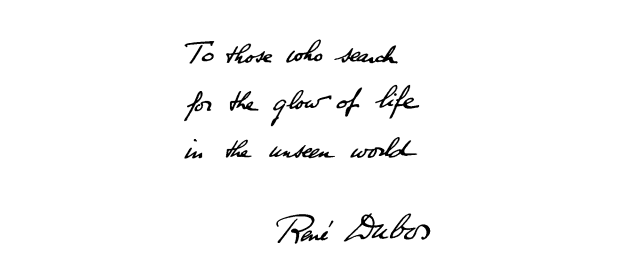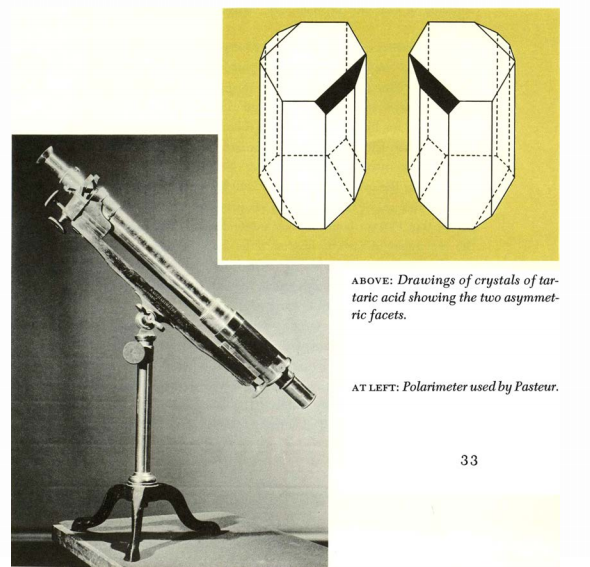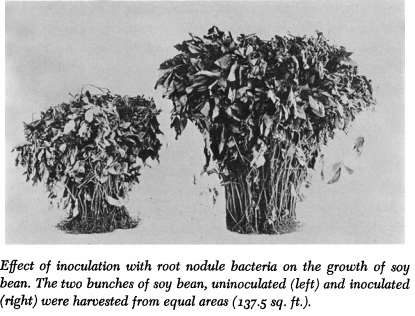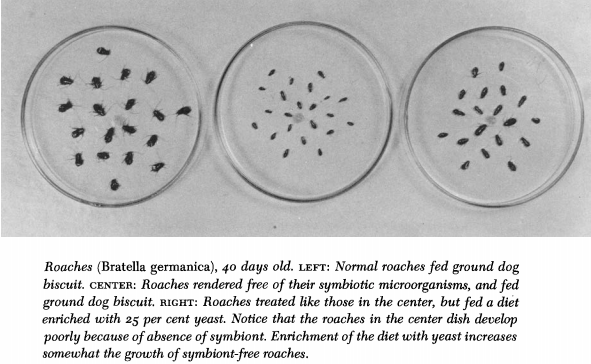The Unseen World
Wed May 27, 2015

The Unseen World is a breezy book, written by Rene Dubos, but originally delivered in lecture format for general lay-audience. This is a light and conversational introduction to the fascinations of the microbial world written from Dubos' understanding that although “we can safely assume that almost everyone now believes that viruses, bacteria, and many other types of microorganisms are capable of causing disease….. this belief is a matter of hearsay and of faith, rather than first hand knowledge based on the kind of personal and direct experience which makes one know that fire burns and that glass cuts.” In order to ease the reader/listener into the story, Rene walks through some of the major early discoveries of microbiology before detailing the power of modern microbiology. He touches on “applied” microbiology and the use of microorganisms for human benefit and then discusses symbiotic organisms and how the interplay of living things indicates that an appropriate scientific attitude is that of an ecologist.
This book is an enjoyable read punctuated by a number of pictures that alone are worth the price of entry (actually the PDF/ebook is available FREE! at the link above.) Who is not fascinated by micrographs of bacterial-viruses, or of bacterial swarms? Who is not impressed by pictures of Robert Koch in Japanese traditional garb or by experiments with cockroaches showing growth defects when fed only irradiated food lacking organisms? The book is begins with the early discoveries of Leeuwenhoek, Koch, Pasteur and Lister. Although the tone and content always aims to be accessible there are some great insights for the practicing microbiologist as well. Here is Dubos describing Pasteur’s early work with tartartic acid:
“It was already known that the solutions of tartaric acid produced naturally during the fermentation of wine rotate the plane of polarized light, whereas those prepared by chemical synthesis are optically inactive. In order to investigate this puzzling fact,the young Pasteur crystallized different salts of tartaric acid and compared their chemical and physical properties.
Placing the various tartrates that he had prepared under the microscope, he noticed that the preparations which were optically inactive yielded crystals which were rather odd in shape. In brief, there seemed to be two kinds of crystals, one kind having small facets oriented to the right with relation to the axis of symmetry, another kind having the same kind of facets but oriented to the left. With infinite care Pasteur proceeded then to separate the two kinds of crystals -with small forceps manipulated by hand under the microscope, mind you! -when he made solutions of each kind of crystals, he found that one solution deviated polarized light to the right, and the other to the left. Furthermore, when he prepared solutions containing equal amounts of the two crystals, the mixtures proved to be optically inactive.
The relation of optical activity to crystalline structure probably seems rather simple and obvious to persons who have studied modern organic chemistry. However, the magnitude of Pasteur’s achievement becomes impressive when one realizes that he was totally unprepared for his findings because there was no knowledge of this field 100 years ago. Moreover Pasteur had at his disposal only a very primitive microscope and polarimeter. No surprise, then, that upon recognizing the relation of optical activity to crystalline shape, he literally ran out of his laboratory shouting in excitement. It is apparent that Pasteur could not have detected the difference between the two types of tartaric crystals if he had not been a very acute observer, and more importantly if his mind had not been bent on finding some fact that would explain the difference in optical activity between the two kinds of tartaric acid. "

This description transports you to Pasteur’s era and allows you to glimpse the power of Pasteur’s insight given the limitations of the technology available to him. Although biographies of Pasteur often describe his work with tartaric acid as a way of bolstering his scientific credentials, they don’t necessarily make the connection with his later work with breweries and vineyards. But see how Dubos tells the tale:
Surprisingly enough it was Pasteur’s early work in crystallography that helped him recognize the nature of the phenomena responsible for defective alcoholic fermentations. One of the observations that provided him with the necessary clue was the finding that the industrial alcohol produced by the fermentation of beet juice was contaminated with large amounts of optically active substances.
Boom! Pasteur was able to suspect/intuit the role of biological agents based on the optical activity of crystals from the wine. Simple observations coupled with powerful intuition. This was Pasteur’s genius and in describing the story in this way, Dubos gives credit to the many early microbiologists who worked in an era where many things could not be observed directly so they must be inferred through indirect observation. These insights would lead Pasteur, and his great rival, Koch, to isolate and observe firsthand the causative agents of disease. I will definitely be checking out Dubos' longer form coverage of this era; I can also recommend Paul de Kruif’s The Microbe Hunters for a fantastic introduction to all of the early “greats”.
Dubos then recounts mankind’s long use of micro-organisms and the manner in which a scientific understanding of these organisms is changing our ability to utilize their capabilities. He covers the use of yeast strains for fermenting beer, wine, and bread, and the exquisite manner in which different bacterial/fungal strains curdle and define the the taste of the various cheeses. These ancient arts have been improved by allowing the cultivation of desirable microbial strains, although the true “domestication” of the unseen world reaches its zenith in the role in understanding how me might be able to combat disease. Although bacterial life can often cause disease, it is a remarkable symmetry that bacteria are also the source of many of the cures. Dubos highlights the rise of antibiotics using penicillin as an example of how hard-won knowledge about a potent compound led to immense efforts at isolation and synthesis which eventually spawned an entire chemical industry with dramatic results for human health. He is rather modest about his role in raising awareness of how antibiotics might be isolated and administered, never even mentioning gramicidin. In addition to antibiotics, Dubos does mention how our understanding of viruses and immunity have led to the other great public health success: vaccines. In a remarkable display of how fast times move, he shows how vaccines are generated by infecting eggs with virus in order secure enough virus to use in vaccines. Although this may be used for some things, one has to imagine that recombinant DNA has made virtually every other method obsolete. On a prescient note, he declines to discuss some contemporary technology stating that one should focus on the timeless ideas and avoid the technologies of the day which invariably change with times. It was a wise choice as there has been a sea change in biology following the discovery of DNA and the rise of molecular biology. And who could have foreseen only a few years ago how dramatically CRISPR would later the landscape of genetic technology?
In his last two sections, Dubos changes gears and talks on the subjects for which, later in life, he earned a reputation: on the beautiful interplay of living things in their native forms, and on the role of scientists and how to live as a scientist. The section on Biological Partnerships highlights a few examples of quirks in nature that Dubos believe represent a powerful trend and possibly a cautionary tale to full-blown reductionism. He highlights how the algae and the fungi of lichen have grown to depend on one another and to behave differently when together than when apart. His description of the patterns of plant leaves and petals as due to viral infection was new to me - I had not realized that these beautiful chaotic patterns were viral in nature. His descriptions of these patterns and his sensibility towards their role in the larger scheme of things is summarized at the end of the chapter:
The biophysical and biochemical unity of life is certainly one of the largest contributions of modern science to philosophical thought. And then, we have come to realize that like other forms of life, microorganisms never exist as isolated entities in nature, and function best when operating together in integrated biological complexes. Thus, unexpectedly, the study of microbial life brings support to moral law by showing that the evolution of biological relationships is toward tolerance and mutual aid.
His last sentence in this Chapter is the segue into his final chapter about Science as a Way of Life, but in many ways it also encapsulates his larger transition from bench scientist to the loquacious, elder statesman of science that he became. Although we may argue about that final line, it seems clear that the study of microbial life did, unexpectedly, lead Rene Dubos to support moral law due to his understanding of the biological roles of tolerance and mutual aid; and we are all the better for it.


